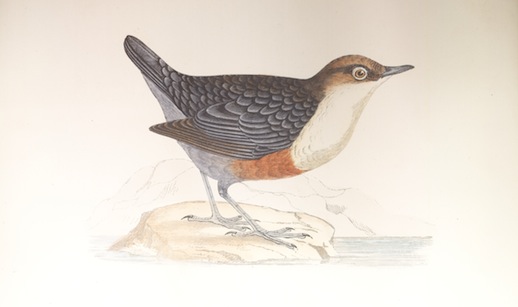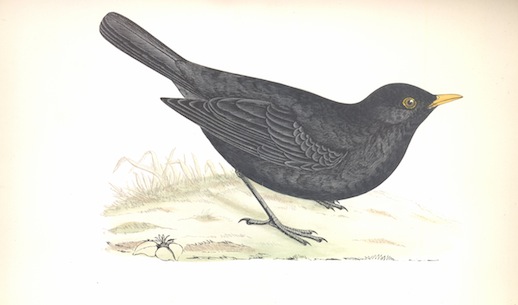 detail from the front page of Eleazer Albin’s ‘A Natural History of English Songbirds’
detail from the front page of Eleazer Albin’s ‘A Natural History of English Songbirds’
by Cheryl Tipp.
The first commercially available record of a singing bird was released in Germany in 1910. ‘Actual Bird Record made by a Captive Nightingale’ was the first of many records that emerged from the Bremen aviary of Herr Karl Reich, canary breeder and collector of song birds. For the first time ever, the general public were able to appreciate the beauty of birdsong from the comfort of their living rooms. Gramophone records of singing birds became increasingly popular during the following decades, with more and more 78s being released by labels such as HMV, Colombia and Decca. The first identification guides appeared in the mid 1930s and the emergence of vinyl led to a veritable explosion of records.
 a Song Thrush plate from the book, ‘A Natural History of English Songbirds’
a Song Thrush plate from the book, ‘A Natural History of English Songbirds’
Before the advent of recorded sound however, the written word was the only real tool for bringing the wonders of birdsong to the masses. What really interests me is how birdsong was described during that time and how very different it is from today. Look in any contemporary identification guide and you’ll be lucky if more than a sentence crops up. “Loud, sweet sounding, rather plaintive pew-pew” or “display song on breeding grounds is a piping trill” is about as good as it gets. Go back a couple of hundred years however and the beauty of the language almost matches the beauty of the songs the authors were trying to describe. Even before getting down to the business of waxing lyrical on the many attributes of individual species, we come across the most exquisite passages that speak of the merits of birdsong. In the preface to his 1759 book ‘A Natural History of English Song-birds’, naturalist and water-colourist Eleazar Albin wrote:
Singing birds are so pleasant a part of the Creation; whether we consider their variety, beauty or harmony; that the animal world does not afford more agreeable objects to the eyes, nor none that so sweetly gratifies the sense of hearing: They were, undoubtedly, designed by the great Author of Nature, on purpose to entertain and delight mankind who, for the generality, are well pleased with the pretty innocent creatures.
Albin was not the only author to praise the virtues of birdsong. A century later, the following words graced the opening pages of ‘British Land Birds’ (The Religious Tract Society, 1857):
Birds are, perhaps, the most purely pleasure-inspiring of all the living creatures we see around us. They are full of attraction, when we consider the elegance of their form, the beauty of their colours, the variety and grace of their movements and the sweet melody of song with which they charm our ears; and you may always enjoy the pleasure they afford, since, go where you will, be the place and season what they may, there is always a bird to be found, which, attentively considered, will afford you instruction and pleasure.
Written accounts of individual bird voices were no less voluble in their admiration. One gentleman with a lovely turn of phrase was the Reverend Francis Orpen Morris, an Irish clergyman and “parson-naturalist” who authored several books on natural history during the 19th century. His ‘A History of British Birds’ series, published over eight years in the mid 1800s, is full of beautifully crafted, almost poetic descriptions. Take his words on the voice of the Song Thrush:
As for the note, that man can have no music in his soul, who does not love the song of the Throstle. Who would not stand still to listen to it in the tranquil summer evening, and look for the place of the vocalist? Presently you will discover the delightful bird pouring forth his lay from the top of some neighbouring tree; you will see his throat swelling with his love song, and hear it you may, if you choose to linger, till sable night casts her dark mantle all around, and wraps the face of nature in the shroud.
The calm eventide is the hour at which he most delights to sing, and rich and eloquent then, as always, are his strains. Uninterruptedly he warbles the mellifluous and harmonious sounds, which now rise in strength, and now fall in measured cadences, filling your ear with the ravishing melody, and now die away so soft and low, that they are scarcely audible. If you alarm him, you break the charm; he will suddenly cease, and silently drop into the underwood beneath.
Morris was also a fan of the Mistle Thrush:
Perched on the topmost bough of some tall tree that quivers to the blast, and heralding, or bidding as it were defiance to the boding gale, the Storm-cock whistles his wanted lay, and gains from the observant countryman his well-earned name. Other birds retire “with bated breath” to the shelter of the lowly grove, or the humble hedge, but he braves the tempest out, and sings his song with Æolus himself.
 Dipper, from Reverend Morris’ History of British Birds.
Dipper, from Reverend Morris’ History of British Birds.
Delving deeper into Morris’ writings we come across a charming account of the song of the water-loving Dipper:
The song of this interesting bird is melodious and lively, though short. It is to be heard in sunny weather, at all seasons of the year – a sweet accompaniment to the murmuring music of the rippling trout stream, which soothes the ear and the heart of the solitary fly-fisher, as he quietly wends his way along, at peace with all the world.
 Blackbird, from Reverend Morris’ History of British Birds.
Blackbird, from Reverend Morris’ History of British Birds.
Surprisingly, Morris was not at all impressed by the Blackbird, one of Britain’s most common and most loved songbirds. He wrote:
With regard to the song of the Blackbird, it has long been my opinion that he is neither more nor less than a Mocking-bird, and that all his best notes are borrowed from those of the Thrush, to which, as is the case with most imitations of an original, they are much inferior.
Scathing words indeed from the dear Reverend.
The liquid notes of the Skylark caught the attention of Henry Gardiner Adams in his 1851 publication ‘Favourite Song birds; a description of the feathered songsters of Britain’:
In the whole range of nature’s various melodies, we know of nothing so thrilling, so estatic, so full of gushing, uncontrollable joy and gladness, as the song of the Lark, heard on a clear spring morning, as high up in the azure dome it soars and sings, as if, indeed, as the old English divine Jeremy Taylor says – “it had learned music and motion of an angel”.
Natural history books and treatises from the 19th Century are awash with this kind of reverential treatment. To finish we turn to the Nightingale and a passage from Frederic Shoberl’s ‘The Natural History of Birds’:
It is from association that this bird derives most of its power of disposing the heart to melancholy impressions. Cheerful and happy itself, it has, aided by the gloom and silence of night, power to draw tears from all that listen to its warblings. Walton, a writer of genuine feeling and classical simplicity, has celebrated the song of this bird with the truest measure of applause. “He that at midnight, when the very labourers sleep securely, should hear, as I have heard, the clear air, the sweet descants, the natural rising and falling, the doubling and redoubling of her voice, might well be lifted above earth and say ‘Lord, what music hast thou provided for thy saints in heaven, when thou affordest bad men such music on earth.
Somewhere along the line these expressive, emotional and romantic depictions fell out of favour and a more scientific, measured approach was adopted. Many of our contemporary nature writers are able to paint evocative pictures of our favourite feathered songsters but traditional identification guides have sadly lost the knack. It’s in the writings of Victorian naturalists that readers can really experience an unreserved, unabated and unequivocal love for the sounds of the natural world.
Cheryl Tipp is the curator of wildlife sound recordings at the British Library, she recently edited a field recording special of the Caught by the River fanzine, An Antidote To Indifference, which you’ll find for sale in our shop, priced £4.00